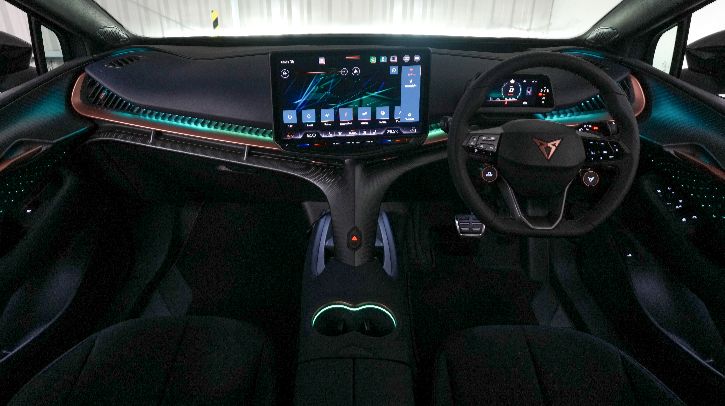The Cupra Tavascan electric SUV features interior lighting inspired by the psychology of color, offering six lighting modes — Liquid, Pulse, Electrified, Speed, Boreal and Custom — that enable “an immersive, emotionally charged driver experience”, the auto maker says.
Lighting can be customized across multiple interior zones, including the dashboard LED strip, door panels, footwells and cupholders, enabling the driver to affect the cabin mood.
Karen Haller, a behavioral color and design psychology expert, explains, “Color has always played a powerful role in how we experience the world around us. When used with intention, it can help us feel calm, energized, focused, or at ease, and those emotional states naturally influence how we behave. The same applies within a car interior where the colors around us can influence how we feel, which in turn can affect how we drive.”
“Even without color, emotions play a key role in driving behavior. If you feel angry or anxious, you tend to drive in an angry or anxious way. Similarly, if you feel relaxed or at ease, you’re likely to drive in that manner.

“The interior lighting in a car, particularly in models like the Cupra Tavascan, is designed around how different wavelengths of light (rather than pigment colors) influence mood and alertness. These lighting effects work through the color temperature and spectral composition of the light itself, which interact directly with our visual and neurological systems. Essentially, different wavelengths of light influence how we feel and behave. Warmer light wavelengths such as amber, red and soft orange can promote relaxation and visual comfort, helping the driver unwind and preserving night vision by causing less pupil constriction.
“Cooler, shorter-wavelength blue light suppresses melatonin and stimulates the brain, encouraging alertness and focus similar to the effect of natural daylight, which is rich in blue wavelengths.
“Mid-spectrum greens offer visual comfort and a sense of balance, helping to steady the senses after a demanding day. By adjusting the color temperature and brightness, drivers can create the lighting environment that best supports how they want to feel, whether relaxed, balanced or energized.
“Being able to adjust the lighting gives the driver a sense of autonomy and control. The more influence drivers have over their environment, the more settled and in control they’re likely to feel behind the wheel.”
Jorge Diez, head of design at Cupra, said, “For us, the Cupra Tavascan is a piece of art that’s never been seen before in automotive capacity. Its design is fully built with emotion and evocation at its core. The ambient lighting setup in a Tavascan is one of the key building blocks into how it comes together, using light to affect the mood and emotion of the driver. Cupra at its heart is more than a car – it’s the feeling you get when you step in, switch the engine on and let yourself become at one with the road.”
In related news, Art deco meets AI in Mercedes-Benz’s Vision Iconic concept



